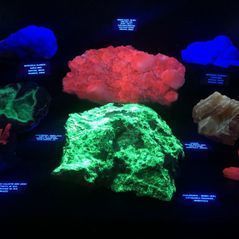
Fluorescence in geology is a term used to describe a mineral's ability to absorb certain wavelengths of ultraviolet light and emit it at a different wavelength. That ability causes the mineral to appear in drastically luminous and vibrant colors under ultraviolet (UV) lights. Under the "black lights" the reaction with the chemicals in the minerals causes them to fluoresce.
The first discovered "glowing" mineral was originally known as fluorospar and is now referred to as fluorite--it was named by George Stokes in 1852. Typical fluorescent minerals include: aragonite, apatite, calcite, powellite, scheelite, sodalite, willemite, and zircon, each with their own colors and levels of brilliance.
The Western Museum of Mining and Industry is proud to host one of the largest collections in the west. Six cases of fluorescent minerals are on long-term loan from the collection of Mr. Conrad North. The Mineral Exhibit is included with your admission.
